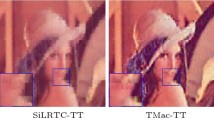Abstract
Low-rank tensor factorization (LRTF) provides a useful mathematical tool to reveal and analyze multi-factor structures underlying data in a wide range of practical applications. One challenging issue in LRTF is how to recover a low-rank higher-order representation of the given high dimensional data in the presence of outliers and missing entries, i.e., the so-called robust LRTF problem. The L 1-norm LRTF is a popular strategy for robust LRTF due to its intrinsic robustness to heavy-tailed noises and outliers. However, few L 1-norm LRTF algorithms have been developed due to its non-convexity and non-smoothness, as well as the high order structure of data. In this paper we propose a novel cyclic weighted median (CWM) method to solve the L 1-norm LRTF problem. The main idea is to recursively optimize each coordinate involved in the L 1-norm LRTF problem with all the others fixed. Each of these single-scalar-parameter sub-problems is convex and can be easily solved by weighted median filter, and thus an effective algorithm can be readily constructed to tackle the original complex problem. Our extensive experiments on synthetic data and real face data demonstrate that the proposed method performs more robust than previous methods in the presence of outliers and/or missing entries.
Similar content being viewed by others
References
Vasilescu M A O, Terzopoulos D. Multilinear analysis of image ensembles: Tensorfaces. In: Proceedings of the European Conference on Computer Vision. Berlin: Springer, 2002. 447–460
Jollife I. Principal Component Analysis. Berlin: Springer Verlag, 1986
Samuel A L. Independent component analysis: A new concept? Signal Process, 1994, 36: 287–314
Martinez A M, Kak A C. PCA versus LDA. IEEE Trans PAMI, 2001, 23: 228–233
Lee D D, Seung H S. Learning the parts of objects by non-negative matrix factorization. Nature, 1999, 401: 788–791
Kolda T, Bader B. Tensor decompositions and applications. SIAM Review, 2009, 51: 455–500
Croux C, Filzmoser P. Robust factorization of a data matrix. In: Proceedings in Computational Statistics. Berlin: Springer, 1998. 1–6
De la Torre F, Black M J. A framework for robust subspace learning. IJCV, 2003, 54: 117–142
Kwak N. Principal component analysis based on l1-norm maximization. IEEE Trans PAMI, 2008, 30: 1672–1680
Ding C, Zhou D, He X F, et al. R1-pca: Rotational invariant l1-norm principal component analysis for robust subspace factorization. In: Proceedings of the International Conference on Machine Learning. New York: ACM Press, 2006. 1–8
Meng D Y, Xu Z B, Zhang L, et al. A cyclic weighted median method for L1 low-rank matrix factorization with missing entries. In: Proceedings of the Association for the Advancement of Artificial Intelligence. Carol Hamilton: AAAI Press, 2013. 1–7
Ke Q, Kanade T. Robust l 1 norm factorization in the presence of outliers and missing data by alternative convex programming. In: Proceedings of Computer Vision and Pattern Recognition. IEEE Press, 2005. 739–746
Eriksson A, van den Hengel A. Efficient computation of robust low-rank matrix approximations in the presence of missing data using the l 1 norm. In: Proceedings of Computer Vision and Pattern Recognition. IEEE Press, 2010. 771–778
Meng D Y, De la Torre F. Robust matrix factorization with unknown noise. In: International Conference on Computer Vision. IEEE Press, 2013. 1337–1344
Gao C Q, Meng D Y, Yang Y, et al. Infrared patch-image model for small target detection in a single image. IEEE Trans Image Proc, 2013, 22: 4996–5009
Buchanan A M, Fitzgibbon A W. Damped Newton algorithms for matrix factorization with missing data. In: Proceedings of Computer Vision and Pattern Recognition. IEEE Press, 2005. 316–322
Greub W H. Multilinear Algebra. Berlin: Springer Verlag, 1967
Tucker L R. Some mathematical notes on three-mode factor analysis. Psychometrika, 1966, 31: 279–311
Vasilescu M A O, Terzopoulos D. Multilinear image analysis for facial recognition. In: International Conference on Pattern Recognition. IEEE Press, 2002. 205–211
de Lathauwer L. Signal processing based on multilinear algebra. PhD Thesis. Leuven: Katholieke Univ, 1997
Vasilescu M A O, Terzopoulos D. Multilinear subspace analysis of image ensembles. In: Proceedings of Computer Vision and Pattern Recognition. IEEE Press, 2003. 93–99
Huang H, Ding C. Robust tensor factorization using r1-norm. In: Proceedings of Computer Vision and Pattern Recognition. IEEE Press, 2008. 1–8
Nie F P, Huang H, Ding C, et al. Robust principal component analysis with non-greedy l 1-norm maximization. In: International Joint Conference on Artificial Intelligence. Carol Hamilton: AAAI Press, 2011. 1433–1438
Inoue K, Hara K, Urahama K. Robust simultaneous low rank approximation of tensors. In: Advances in Image and Video Technology. Berlin: Springer, 2009. 574–584
Zhao Q, Meng D Y, Xu Z B, et al. Robust principal component analysis with complex noise. In: Proceedings of the International Conference on Machine Learning. New York: ACM Press, 2014. 1–9
Friedman J, Hastie T, Höfling H, et al. Pathwise coordinate optimization. Annals Appl Statistics, 2007, 1: 302–332
Friedman J, Hastie T, Tibshirani R. Regularized paths for generalized linear models via coordinate descent. JSTAT SOFTW, 2010, 33: 1–22
Tseng P. Convergence of a block coordinate descent method for nondifferentiable minimization. JOTA, 2001, 109: 475–494
Rauh A, Arce G R. A fast weighted median algorithm based on quickselect. In: IEEE International Conference on Image Processing. IEEE Press, 2010. 105–108
Author information
Authors and Affiliations
Corresponding author
Rights and permissions
About this article
Cite this article
Meng, D., Zhang, B., Xu, Z. et al. Robust low-rank tensor factorization by cyclic weighted median. Sci. China Inf. Sci. 58, 1–11 (2015). https://doi.org/10.1007/s11432-014-5223-4
Received:
Accepted:
Published:
Issue Date:
DOI: https://doi.org/10.1007/s11432-014-5223-4




